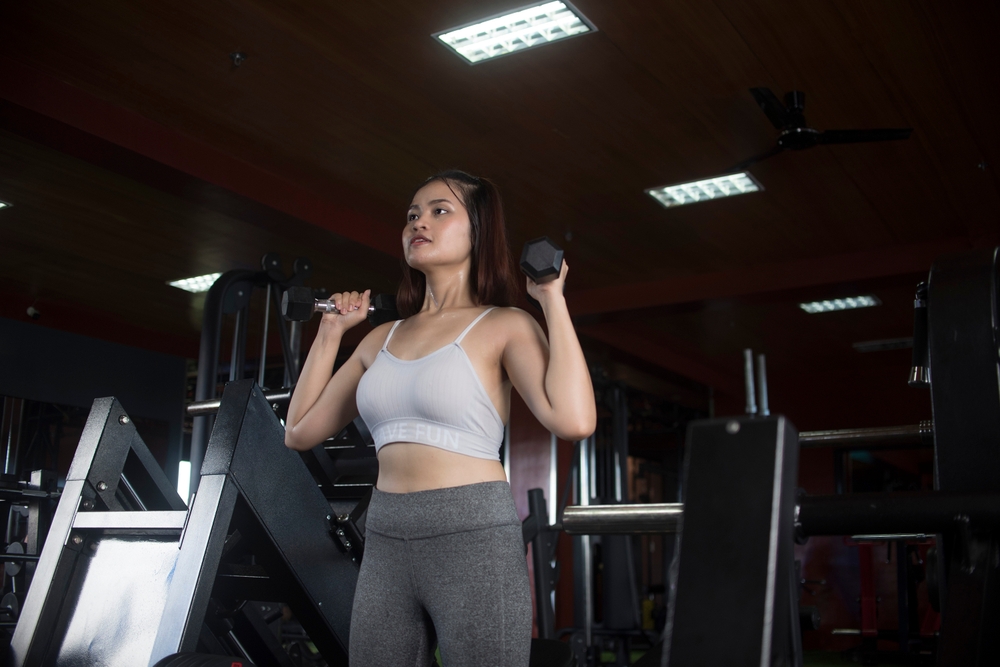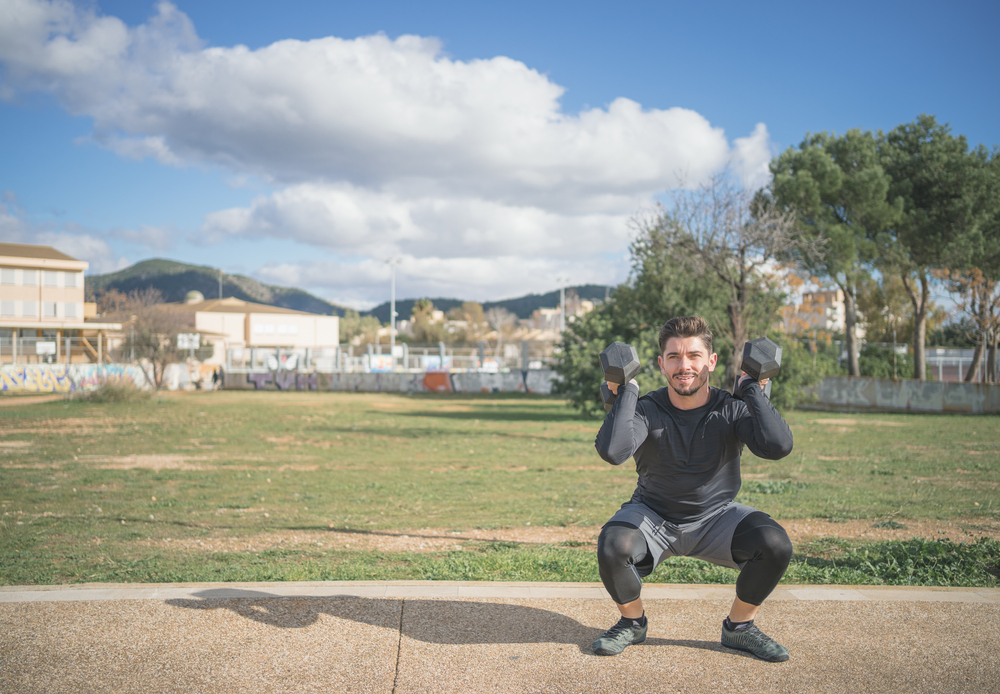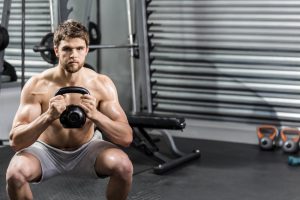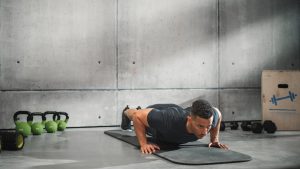The dumbbell squat and press combines a squat with an overhead press into one fluid movement that targets your entire body in a single exercise.
To perform it correctly, start with dumbbells at shoulder height, squat down until your thighs are parallel to the ground, then explosively drive through your heels while simultaneously pressing the weights overhead until your arms are fully extended.
Keep reading for the complete step-by-step breakdown, common mistakes to avoid, and how to progress this powerful compound movement safely and effectively.
Understanding the Dumbbell Squat and Press Foundation
The dumbbell squat and press, commonly called a “Thruster,” represents one of the most efficient compound exercises you can add to your training arsenal.
This movement pattern seamlessly blends two fundamental human movements—squatting and pressing—into a single, coordinated action that delivers maximum training bang for your buck.
Primary Muscle Activation
Your body recruits multiple major muscle groups during this exercise.
The squatting portion primarily targets your quadriceps, hamstrings, and glutes, while the pressing phase engages your deltoids, triceps, and core muscles.
This multi-joint involvement means you're working six major muscle groups simultaneously rather than isolating individual muscles.
Beyond these primary movers, your pectorals, trapezius, and various stabilizing muscles throughout your torso and legs work continuously to maintain proper positioning and control.
These secondary muscles act as your body's internal support system, keeping you balanced and aligned throughout the entire movement.
Compound Movement Advantages
Unlike isolation exercises that target single muscles, the dumbbell squat and press forces multiple muscle groups to work together in coordination.
This creates a training stimulus that mirrors how your body actually functions in real-world situations.
You're not just building individual muscle strength—you're developing the neuromuscular coordination that translates directly to daily activities.
The exercise also delivers superior time efficiency.
Instead of performing separate squat and overhead press exercises, you accomplish both movement patterns in one fluid motion, cutting your workout time while maintaining training effectiveness.
Functional Strength Development
What sets this exercise apart is its direct carryover to everyday movements.
Think about the last time you lifted a heavy box from the floor to a high shelf, or helped someone move furniture.
These activities require the exact same movement pattern: squatting down, engaging your core, and pressing upward while maintaining balance and control.
Training this pattern with resistance builds strength in the specific muscles and movement sequences you use daily, making routine tasks feel easier and reducing your risk of injury during unexpected physical demands.
Step-by-Step Movement Execution
Proper execution starts with precise positioning and flows through four distinct phases that blend into one seamless movement.
Each phase requires specific attention to detail, but the magic happens when they connect naturally together.
Starting Position Setup
Position your feet shoulder-width apart—this gives you the stable base you need for both squatting and pressing phases.
Hold a dumbbell in each hand at shoulder height with your elbows bent at approximately 90 degrees.
Your palms should face forward or slightly inward toward each other, whichever feels more comfortable and secure.
This starting position creates the foundation for everything that follows.
Your shoulders should feel stable, your core engaged, and your weight evenly distributed across both feet.
The Squat Phase
Initiate the movement by pushing your hips back first, then bending at the knees.
Keep your back straight and ensure your knees track behind your toes—never let them drift forward past your foot position.
Lower yourself until your thighs reach parallel to the ground, or as low as your mobility allows.
Here's a key technique: imagine you're screwing your feet into the floor by actively pressing your ankles, lower legs, and thighs outward.
This creates tension through your entire leg structure and activates your glutes more effectively than simply dropping down into the squat.
The Press Phase
Drive through your heels explosively to stand up from the squat position while simultaneously pressing the dumbbells overhead.
This dual action should feel coordinated, not like two separate movements happening at once.
Extend your arms fully until they're straight overhead with the dumbbells positioned directly above your shoulders.
At the top position, your biceps should align with your ears—this indicates proper overhead positioning and optimal shoulder mechanics.
Return Phase Control
Lower the dumbbells back to shoulder height with deliberate control while simultaneously descending back into the squat position.
This isn't a collapse or a drop—you're actively controlling both the lowering of the weights and your body position throughout the descent.
This controlled return sets you up perfectly for the next repetition and maintains constant tension on your muscles throughout the entire exercise.
Movement Flow Integration
The key to mastering this exercise lies in the transition timing.
Start driving your elbows upward once your knees pass the 90-degree mark during your ascent from the squat.
This creates one fluid movement pattern rather than a squat followed by a press.
Think of it as a wave of motion that starts from your feet, travels through your legs and core, and culminates with your arms pressing overhead.
When executed properly, each repetition should feel like a single, coordinated action rather than multiple separate movements.
Critical Form Elements and Breathing Technique
Mastering the technical details separates effective execution from potentially harmful movement patterns.
These form elements work together to create stability, power, and safety throughout every repetition.
Core Engagement Strategies
Your core acts as the central command center for this exercise, connecting your lower and upper body movements.
Actively engage your abdominal muscles as if someone were about to playfully punch you in the stomach—this creates the internal pressure needed to support your spine during both the squatting and pressing phases.
This abdominal activation serves multiple purposes: it protects your lower back from excessive stress, improves your balance when transitioning between movement phases, and provides a stable platform for generating power through your arms during the overhead press.
Foot Mechanics and Weight Distribution
Your feet are your connection to the ground, and proper mechanics here determine the effectiveness of your entire movement.
Press into your heels rather than your toes as you stand up from the squat—this simple shift dramatically improves glute activation and provides more stable power transfer.
When your weight shifts forward onto your toes, you lose access to your most powerful leg muscles and create an unstable base for the overhead press.
Heel emphasis keeps you grounded and allows your posterior chain to contribute fully to the movement.
Knee Alignment Principles
Your knees should track directly over your toes throughout the entire range of motion.
This alignment protects your knee joints and ensures optimal force production from your leg muscles.
Watch for any tendency of your knees to collapse inward—this common fault reduces power output and increases injury risk.
If you notice inward knee drift, it often indicates weakness in your glutes or outer hip muscles.
Focus on actively pushing your knees outward in the same direction as your toes, especially during the most challenging portion of the squat.
Breathing Pattern Coordination
Proper breathing enhances both performance and safety. Inhale as you descend into the squat, filling your lungs to create additional core stability.
Exhale forcefully as you drive up and press the weights overhead—this exhalation helps maintain core tension while allowing for maximum power output.
This breathing pattern isn't just about oxygen delivery—it's a core stability strategy that helps maintain proper spinal alignment throughout the movement.
The coordinated breath work supports your abdominal engagement and improves your overall control.
Chest Position and Posture
Keep your chest lifted and shoulders back throughout the entire movement.
Your torso should maintain an upright position during the squat phase, avoiding any forward lean or rounding.
This upright posture sets you up for an efficient transition into the overhead press and prevents compensation patterns that can stress your lower back.
Think about keeping your chest proud and your shoulder blades pulled slightly together.
This positioning optimizes your shoulder mechanics for the pressing phase while maintaining the spine-friendly posture needed during the squat portion.
Common Mistakes and Corrective Solutions

Even experienced lifters fall into predictable form breakdowns with this complex movement.
Recognizing these mistakes early and applying targeted corrections prevents injury and accelerates your progress.
Knee Valgus: The Inward Collapse Problem
When your knees cave inward during the squat portion, you're experiencing knee valgus—one of the most common and problematic form breakdowns.
This happens when the muscles that control your hip and knee alignment can't handle the load you're asking them to manage.
The immediate fix is simple: reduce your dumbbell weight for subsequent sets until you can maintain proper knee tracking.
For long-term improvement, incorporate mini-band exercises into your warm-up routine.
Place a resistance band around your thighs just above your knees and perform bodyweight squats, focusing on pushing against the band throughout the movement.
This strengthens the muscles responsible for maintaining proper knee alignment.
Rounded Back During the Squat
A rounded or hunched back during the squat phase signals that your core strength isn't sufficient for the load you're attempting to lift.
This compensation pattern puts excessive stress on your spine and reduces the exercise's effectiveness.
Drop your dumbbell weight immediately when you notice this happening.
Before progressing back to heavier weights, spend several weeks strengthening your core with planks and hyperextensions.
These exercises build the foundational strength your spine needs to maintain proper positioning under load.
Only increase resistance once you can complete all repetitions with a straight, stable back.
Back Arching During the Press Phase
Excessive back arch when pressing the dumbbells overhead typically stems from insufficient upper-body and core strength.
Your body compensates for these weaknesses by using your lower back as a lever, creating a dangerous stress pattern.
Reduce your weight and focus intensely on keeping your core tight and your ribs pulled down as the dumbbells move overhead.
Think about maintaining the same torso position you had during the squat phase—don't let your back change angles just because you're pressing overhead.
This correction often requires significant weight reduction initially, but it builds the proper strength patterns for safe progression.
Toe-Dominant Weight Distribution
Shifting your weight forward onto your toes during the squat eliminates muscle activation in your most powerful leg muscles.
When this happens, you'll notice that your legs don't feel much work, and you lose the power needed for an effective transition into the press phase.
The solution requires conscious attention to heel pressure throughout the entire movement.
Think about driving through your heels from the moment you begin descending into the squat until you complete the overhead press.
This simple focus shift dramatically improves glute activation and provides the stable platform needed for optimal performance.
Insufficient Squat Depth
Half-squats and quarter-squats might feel easier, but they seriously compromise your leg development and actually increase injury risk by training incomplete movement patterns.
Proper depth means your thighs should reach parallel to the ground, or as close as your current mobility allows.
If you can't achieve adequate depth, the problem usually involves either excessive weight or mobility limitations.
Start by reducing the load and focusing on reaching proper depth with lighter dumbbells.
If mobility is the limiting factor, incorporate hip and ankle flexibility work into your routine before attempting to add resistance back to the movement.
Work on achieving full range of motion before worrying about how much weight you can lift—proper depth with lighter weight delivers better results than partial range of motion with heavier loads.
Weight Selection and Progressive Programming
Choosing appropriate weights and progressing systematically separates successful long-term development from frustrating plateaus and potential injuries.
Smart programming starts conservative and builds methodically.
Beginner Weight Assessment
Two simple tests help you find your starting weight. First, try the hold test: select a dumbbell and hold it at arm's length in front of you.
If you can't maintain this position for at least 5 seconds, it's too heavy.
If you can hold it for more than 30 seconds, it's probably too light.
This gives you a practical baseline for upper-body readiness.
Alternatively, start with dumbbells that represent approximately 5-10% of your body weight.
For a 150-pound person, this means beginning with 8-15 pound dumbbells.
This conservative approach prioritizes movement quality over ego lifting and sets the foundation for consistent progress.
Form Mastery Prerequisites
Never add external resistance until you've mastered the movement pattern with just your body weight.
Spend your first several sessions performing bodyweight squats and practicing the coordination between squatting and arm movements without any dumbbells.
If possible, work through the complete dumbbell squat and press movement with no weight while a knowledgeable coach observes your technique.
This investment in movement quality pays dividends throughout your training career and prevents the formation of compensatory movement patterns that become harder to correct later.
Set and Rep Programming Structure
Structure your training around 3-set protocols, which provide sufficient volume for strength development without excessive fatigue.
Begin with 2 sets of 10 repetitions and focus on perfect execution of every single rep.
Monthly progression keeps your development steady and sustainable.
Month one might involve 2 sets of 10 reps, month two progresses to 2 sets of 12 reps, and month three advances to 3 sets of 10 reps.
This systematic approach ensures you're always challenging your body while maintaining technical precision.
Progressive Overload Applications
You have multiple tools for advancing your training beyond simply adding weight.
Increase your dumbbell load by 2-5% each week when you can complete all prescribed repetitions with perfect form.
This might mean jumping from 15-pound dumbbells to 16-pound dumbbells—small increments compound into significant strength gains.
Other progression methods include adding repetitions to your existing sets, incorporating additional sets, reducing rest time between sets, or focusing on increasing your squat depth.
Each approach challenges your body differently and prevents adaptation plateaus that halt progress.
Recognizing Appropriate Challenge Levels
Your last 2-3 repetitions in each set should feel challenging but still allow you to maintain perfect form.
If you can complete 10 repetitions easily with energy to spare, you need to increase the difficulty.
Conversely, if you're struggling to maintain proper technique by rep 7 or 8, the load is too demanding.
Target a weight that allows you to complete approximately 10 quality repetitions, with the final few requiring genuine effort.
This sweet spot provides sufficient stimulus for strength development while preserving the movement quality that keeps you injury-free and progressing consistently.
The key is patient consistency—small, regular increases in challenge level produce far better long-term results than dramatic jumps that compromise your technique or lead to overuse injuries.
Benefits, Progressions, and Safety Guidelines
The dumbbell squat and press delivers exceptional returns on your training investment, but maximizing these benefits requires understanding both its advantages and how to progress safely over time.
Full-Body Development Advantages
This exercise engages your quadriceps, hamstrings, glutes, deltoids, and core muscles simultaneously rather than targeting them individually.
This coordinated muscle recruitment builds functional strength while developing the neuromuscular coordination that connects different body segments into one integrated system.
The simultaneous engagement also enhances both strength and muscular endurance.
You're training your muscles to work together under resistance, which improves their ability to sustain effort over time.
This dual benefit means you're building power for short bursts while developing the stamina needed for longer physical activities.
Functional Strength Applications
Real-world activities rarely involve isolated muscle movements—they require the same squat-to-overhead pattern you're training.
Whether you're lifting luggage into an overhead compartment, moving boxes during a household project, or playing with children at the park, you're using this exact movement sequence.
Training this pattern with resistance strengthens the muscles in the specific coordination they'll need during daily activities.
This preparation makes routine tasks feel easier and significantly reduces your risk of injury during unexpected physical demands.
Your body becomes more resilient because you've trained it to handle these movement patterns efficiently.
Metabolic Benefits
Compound movements like the squat and press create substantial energy demands that extend beyond your workout session.
Engaging multiple large muscle groups simultaneously requires more calories during the exercise itself, but the metabolic boost continues for hours afterward as your body recovers and adapts.
This elevated post-exercise energy expenditure occurs because your body must repair and strengthen multiple muscle groups, restock energy stores, and process the metabolic byproducts created during high-intensity, multi-muscle training.
The result is increased calorie burn both during and after your workout.
Advanced Progressions for Experienced Lifters
Once you've mastered the basic movement, several progressions can intensify the challenge.
Increase your squat depth beyond parallel to engage your muscles through a greater range of motion.
Single-leg variations force each leg to work independently while dramatically increasing core stability demands.
Focus on explosive execution—drive out of the squat as powerfully as possible while maintaining control.
For additional instability challenge, perform the movement on an unstable surface like an inverted Bosu ball, though this requires excellent mastery of the basic movement first.
Advanced athletes can also transition to a squat clean and press variation, where you catch the dumbbells at shoulder height during the upward drive, adding a coordination and timing element that further increases the exercise complexity.
Safety Protocol Requirements
Never attempt progressive overload until you've mastered the exercise with perfect form and maintained the same routine for at least 2 weeks—ideally a full month.
This timeline allows your connective tissues to adapt to the movement demands and ensures your technique is consistent before adding additional challenges.
Recovery between sessions is non-negotiable. Allow adequate rest days between training sessions and immediately scale back intensity if you experience significant soreness or any signs of injury.
Your body adapts and grows stronger during recovery periods, not during the workouts themselves.
Monitor your response carefully and adjust accordingly.
Some muscle soreness after training is normal, but persistent pain, joint discomfort, or movement quality deterioration signals the need for reduced intensity or additional recovery time.
Successful long-term progress requires balancing challenge with sustainability—pushing hard enough to drive adaptation while respecting your body's current capacity and recovery needs.
Conclusion
The dumbbell squat and press stands out as one of the most efficient exercises you can perform, delivering full-body strength development while improving functional movement patterns that translate directly to daily activities.
Success with this movement comes from prioritizing perfect form over heavy weight, progressing systematically, and maintaining consistency in your training approach.
Master the fundamentals first, progress patiently, and you'll build the kind of practical strength that makes everything else in life feel easier.







